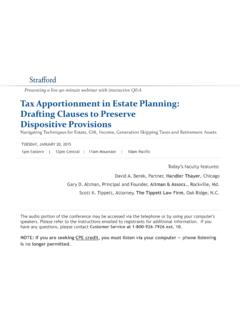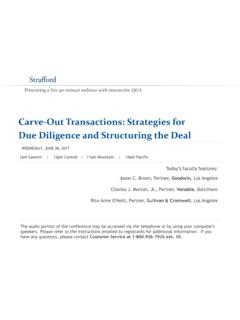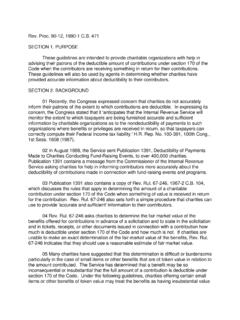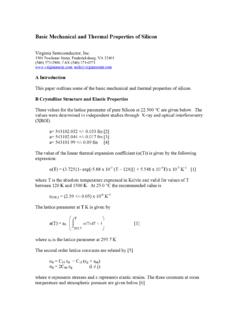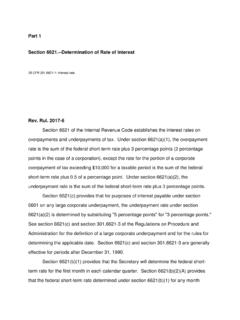Transcription of Consolidated Group Tax Allocations: Navigating ...
1 Consolidated Group Tax Allocations: Navigating Consolidated Return Rules Leveraging allocation Agreements in Acquisitions, Spin-Offs, Issuances of Stock; Implementing New Interagency Guidance for Banks Today s faculty features: 1pm Eastern | 12pm Central | 11am Mountain | 10am Pacific WEDNESDAY, NOVEMBER 12, 2014 Presenting a live 90-minute webinar with interactive Q&A Stanley Barsky, Esq., Cooley, New York Keith Fisher, Of Counsel, Ballard Spahr, Washington, Wayne Strasbaugh, Partner, Ballard Spahr, Philadelphia The audio portion of the conference may be accessed via the telephone or by using your computer's speakers. Please refer to the instructions emailed to registrants for additional information.
2 If you have any questions, please contact Customer Service at 1-800-926-7926 ext. 10. NOTE: If you are seeking CPE credit, you must listen via your computer phone listening is no longer permitted. Tips for Optimal Quality Sound Quality If you are listening via your computer speakers, please note that the quality of your sound will vary depending on the speed and quality of your internet connection. If the sound quality is not satisfactory, you may listen via the phone: dial 1-866-873-1442 and enter your PIN when prompted. Otherwise, please send us a chat or e-mail immediately so we can address the problem. If you dialed in and have any difficulties during the call, press *0 for assistance.
3 NOTE: If you are seeking CPE credit, you must listen via your computer phone listening is no longer permitted. Viewing Quality To maximize your screen, press the F11 key on your keyboard. To exit full screen, press the F11 key again. FOR LIVE EVENT ONLY Continuing Education Credits For CLE credits, please let us know how many people are listening online by completing each of the following steps: Close the notification box In the chat box, type (1) your company name and (2) the number of attendees at your location Click the SEND button beside the box For CPE credits, attendees must listen throughout the program, including the Q & A session, and record verification codes in the corresponding spaces found on the CPE form, in order to qualify for full continuing education credits.
4 Strafford is required to monitor attendance. If you have not printed out the CPE Form, please print it now (see Handouts tab in Conference Materials box on left-hand side of your computer screen). Please refer to the instructions emailed to registrants for additional information. If you have any questions, please contact Customer Service at 1-800-926-7926 ext. 10. FOR LIVE EVENT ONLY Program Materials If you have not printed the conference materials for this program, please complete the following steps: Click on the ^ symbol next to Conference Materials in the middle of the left-hand column on your screen. Click on the tab labeled Handouts that appears, and there you will see a PDF of the slides for today's program.
5 Double click on the PDF and a separate page will open. Print the slides by clicking on the printer icon. FOR LIVE EVENT ONLY Consolidated Group Tax Allocations: Navigating Consolidated Return Rules Wayne R. Strasbaugh Partner, Ballard Spahr LLP Strasbaugh 215-665-8500 Consolidated Return Tax allocation Methods 6 Consolidated Federal Income Tax Returns A Group comprised of a common parent corporation and its 80%-owned direct and indirect eligible corporate subsidiaries files a single federal income tax return and makes a single tax payment Ineligible corporate subsidiaries such as foreign corporations, REITs and RICs are excluded. Tax consolidation does not match financial consolidation The common parent corporation is the agent of all the members in signing the return, paying the tax and receiving notices and refunds (Reg.)
6 Sec. ) All Consolidated corporations are jointly and severally liable to the IRS for the Group s tax 7 Why Consolidated Groups Allocate Taxes Regulatory Reasons Creditor Concerns (with or without Bankruptcy) Minority Shareholders Tax Concerns 8 Tax Concerns: Intercompany Payments Federal Income Taxes Nondeductible (Code Sec. 275) -But are deductible in determining Earnings and Profits Possible Characterizations of Reimbursement of Tax -Dividend -Capital Contribution -Repayment of Loan 9 Tax Purposes Earnings and Profits (Reg. Sec. ) E & P - Tax Benefit Payments (Reg. Sec. (d)) Stock Basis Adjustments (Reg. Sec. ) 10 E & P: Elect 1 of 4 Basic Methods page 1 Affirmatively made in first Consolidated tax return If no affirmative election, deemed to elect Method 1 Automatic change of method under Rev.
7 Proc. 90-39, 1990-2 365, to Methods 1 to 3 if current method was not adopted in last five taxable years or if current method is initial method. Change is not retroactive Does it matter if no initial election is made given the rare circumstances in which earnings and profits become relevant? 11 E & P: Elect 1 of 4 Basic Methods page 2 Treas. Reg. Sec. (b)(2) Effect of allocation . -The amount of tax liability allocated to a corporation .. shall (i) result in a decrease in the earnings and profits of such corporation in such amount, and (ii) be treated as a liability of such corporation for such amount. If the full amount of such liability is not paid by such corporation, pursuant to an agreement among the members of the Group or otherwise, the amount which is not paid will generally be treated as a distribution with respect to stock, a contribution to capital, or a combination thereof, as the case may be.
8 Note that last sentence of above rule applies even if no Tax allocation Agreement or Affirmative Tax Election 12 Earnings and Profits: Basic Method I Based on Contributions to Consolidated Taxable Income Actual Income Contribution may be less than Separate Taxable Income Members with Current Losses receive no allocation But Members with Credits and Carryovers may receive allocation even though they would not pay tax as unconsolidated corporations 13 Earnings and Profits: Basic Method II Based on ratio of Member Separate Return Tax Liabilities Separate Return Tax Liability: Actual Liability if Separate Return filed but with Timing Adjustments for Intercompany Transactions, ELAs, Stock Basis Adjustments, and Exclusions of Dividends Method Does Allow for Absorption of Credits and Carryovers Attributable to Member 14 Earnings and Profits.
9 Basic Method III Hybrid of Basic Methods I and II -First, apply Basic Method I -Second, determine if Basic Method I produces excess tax for any Member in excess of Basic Method II -Third, reallocate excess Basic Method I tax from second step to Members for whom Basic Method II produces excess over Basic Method I, to extent of excess -Fourth, reallocate any remaining excess from second step among Members in accordance with Basic Method I More popular when there was a Consolidated return surtax but may still be relevant for Members in lower tax brackets 15 Earnings and Profits Basic Method IV Any method approved by the Commissioner Rev. Rul. 57-392, 1957-2 615, approved two-tier Method-I like allocation , first to operational groups and then among Members within operational groups PLR 8446013 (Aug.)
10 8, 1984) approved two-tier Method II-like allocation , first to operational groups and then among Members within operational groups Possible approval of method that allocates based on operational groups that include SMLLCs 16 E & P Complementary Methods: The Problem Methods I through IV do not adjust E & P for absorption of another member s losses and other tax benefits Without complementary method, absorption of loss would reduce E & P of member generating loss and not E & P of member that utilized loss 17 E & P Complementary Methods: Election page 1 Groups may affirmatively elect one of three Complementary Methods. No deemed election Election must be made in first Consolidated tax return Automatic change of Complementary Method under Rev.






